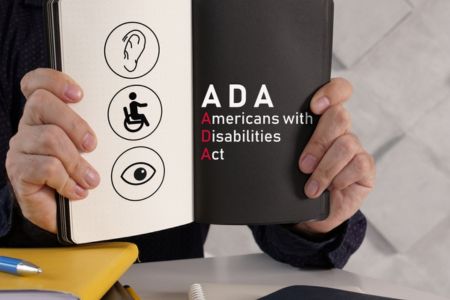Most business owners understand the importance of ADA compliance regarding physical spaces, but many overlook their digital presence. The rise in ADA website compliance lawsuits shows that inaccessible websites can be just as legally risky as non-compliant storefronts. Thousands of businesses have faced legal action for failing to meet web accessibility standards, and the numbers continue to climb. This article breaks down what ADA website lawsuits involve, highlights real-world examples, and offers practical steps to help you protect your business.
ADA Website Compliance Lawsuits: Protecting Your Business
 Website accessibility isn’t just a best practice—it’s a legal requirement that impacts millions of people with disabilities. Under the Americans with Disabilities Act (ADA), corporations must ensure their websites are accessible, just as they would for physical locations. That includes compatibility with assistive technologies, readable text, and alternative descriptions for images and multimedia.
Website accessibility isn’t just a best practice—it’s a legal requirement that impacts millions of people with disabilities. Under the Americans with Disabilities Act (ADA), corporations must ensure their websites are accessible, just as they would for physical locations. That includes compatibility with assistive technologies, readable text, and alternative descriptions for images and multimedia.
Title III of the ADA explicitly requires publicly facing businesses, like restaurants, hotels, retailers, and service providers, to remove digital barriers. If your website isn’t ADA-compliant, your business could be exposed to costly accessibility website lawsuits and reputational damage.
ADA Title III: What You Need to Know
Title III of the ADA prohibits discrimination against individuals with disabilities in places of public accommodation. In 2010, the Department of Justice (DOJ) issued regulations stating that websites must be accessible to people with disabilities.
In 2018, the DOJ withdrew these regulations, but this does not mean businesses are no longer required to comply with the ADA. Instead, the DOJ issued a statement saying that the ADA applies to websites and that businesses should follow the Web Content Accessibility Guidelines (WCAG) 2.1, developed by the World Wide Web Consortium (W3C).
The WCAG provides guidelines on how to make websites accessible, and there are three levels of compliance: A, AA, and AAA. The most commonly cited level is AA, considered the standard for ADA compliance. Businesses must ensure that their site is perceivable, operable, understandable, and robust for all users, including those with disabilities, to be compliant.
Title III of the Americans with Disabilities Act (ADA) prohibits discrimination against individuals with disabilities in places of public accommodation, including websites. Although the Department of Justice (DOJ) initially issued website accessibility regulations in 2010 and later withdrew them in 2018, businesses are still expected to comply.
The DOJ has affirmed that the ADA applies to websites and encourages businesses to follow the Web Content Accessibility Guidelines (WCAG) 2.1, devised by the World Wide Web Consortium (W3C). These guidelines outline how to make digital content accessible, focusing on four key principles: perceivable, operable, understandable, and robust. WCAG compliance is measured in three levels: A, AA, and AAA, with Level AA widely recognized as the standard for ADA website compliance.
ADA Website Compliance Lawsuit Settlements
The number of ADA website accessibility lawsuits has skyrocketed in recent years, with businesses paying millions in legal settlements. In 2022 alone, over 3,200 lawsuits were filed in federal court over non-compliant websites.
ADA website lawsuit settlement amounts vary widely, typically from $5,000 to $20,000—but they can climb into the millions in more serious or high-profile cases. One example is Beyoncé’s Parkwood Entertainment, which faced a suit for failing to make its website accessible to visually impaired users. Though the settlement amount was not disclosed, it’s considered to be substantial.
Another headline-making case involved Domino’s Pizza, which was sued for making its website and app inaccessible to blind users. The case could proceed in federal court after reaching the Supreme Court in 2019, marking a significant legal precedent for digital accessibility.
Examples of ADA Website Compliance Violations
Understanding what puts your website at risk is the first step toward preventing an ADA website compliance lawsuit. Below are some of the most common accessibility violations that lead to legal action:
- Missing Alternative Text for Images: Screen readers can’t convey image content to visually impaired users without descriptive alt text, making your site inaccessible and non-compliant.
- Inaccessible Online Forms: Forms that can’t be completed using a keyboard, lack clear labels, or aren’t compatible with screen readers create barriers for users with disabilities.
- Poor Color Contrast: Inadequate contrast between text and background can make content unreadable for low-vision users. ADA guidelines recommend a minimum contrast ratio of 4.5:1 for standard text.
- No Captions or Transcripts for Multimedia: Videos and audio without captions or transcripts prevent users with hearing impairments from accessing key content.
- No Keyboard Navigation Support: If your website can’t be navigated using a keyboard alone, it’s likely inaccessible to users with mobility or vision challenges.
Because accessibility standards evolve, it’s essential to routinely audit and update your site to stay compliant and avoid becoming the target of a website accessibility lawsuit.
Trends in Web Accessibility Lawsuits
Web accessibility lawsuits have steadily increased over the past decade, signaling a growing legal and consumer focus on digital inclusion. According to UsableNet’s 2022 Midyear Report, more than 3,250 ADA-compliant website lawsuits were filed in federal court in 2022—up from around 2,700 in 2017.
One major factor driving this rise is the expanding interpretation of the ADA to include digital spaces, not just physical locations. The Department of Justice (DOJ) has clarified that websites and mobile apps serving the public must be accessible to people with disabilities, reinforcing the need for compliance across retail, hospitality, healthcare, and education industries.
Plaintiffs and law firms have also become more strategic, regularly testing websites for common accessibility failures before filing claims. The most frequent violations include missing alternative text, lack of keyboard navigation, inaccessible forms, and multimedia content without captions.
As public expectations rise and legal enforcement becomes more aggressive, companies of all sizes are pressured to ensure their digital experiences are inclusive. Proactively identifying and fixing accessibility barriers is no longer optional—it’s a critical safeguard against the growing risk of a web accessibility lawsuit.
What Are the Chances of Winning an ADA Website Compliance Lawsuit?
 The outcome of an ADA website compliance lawsuit can vary widely depending on the circumstances. Courts consider the nature and extent of the website’s accessibility barriers, the evidence provided by both parties, and how the law is interpreted in that jurisdiction.
The outcome of an ADA website compliance lawsuit can vary widely depending on the circumstances. Courts consider the nature and extent of the website’s accessibility barriers, the evidence provided by both parties, and how the law is interpreted in that jurisdiction.
It’s important to understand that the ADA is designed to protect individuals with disabilities and requires businesses to provide equal access to their goods and services, including online. If your website is found to be non-compliant, you could face legal action, financial penalties, or mandatory remediation.
Website owners and developers should prioritize digital accessibility rather than take a reactive approach. Following ADA website compliance guidelines and regularly auditing your site can significantly reduce legal risk and demonstrate your commitment to inclusivity.
Top Companies Sued for Website Accessibility
In recent years, ADA website lawsuits have surged, with visually impaired individuals and disability advocacy groups filing claims against major companies whose websites failed to meet accessibility standards. These high-profile cases highlight non-compliance’s legal and financial risks and the growing expectation that digital spaces must be inclusive to all users.
Below is a breakdown of some of the most well-known ADA website compliance lawsuits filed against top companies across industries.
- Beyoncé’s Parkwood Entertainment: In January 2019, a class-action lawsuit was filed against Parkwood Entertainment, the company owned by pop star Beyoncé, alleging that the company’s website was not accessible to visually impaired users. The claim stated that the site violated the Americans with Disabilities Act (ADA) and the California Unruh Civil Rights Act by failing to include components such as alternative text for images and properly labeled link headings. The settlement amount was not disclosed but is believed to be in the millions.
- Domino’s Pizza: In 2016, a blind man named Guillermo Robles filed a lawsuit against Domino’s Pizza, alleging that the company’s site and mobile app were not accessible to people with disabilities. The suit argued that the digital platforms violated the ADA by failing to support screen reader technology, preventing blind and visually impaired users from accessing online services. The case reached the U.S. Supreme Court, which declined to hear Domino’s appeal, allowing the lawsuit to proceed in lower courts.
- Harvard and MIT: The National Association of the Deaf filed a lawsuit against Harvard and MIT in 2015, alleging that the universities’ online courses did not provide adequate closed captioning for deaf and hard-of-hearing students. The lawsuits claimed this failure violated the Americans with Disabilities Act (ADA) and the Rehabilitation Act. The settlement amount was $750,000.
- Netflix: The National Association of the Deaf filed a lawsuit against Netflix in 2012, claiming the streaming platform failed to provide closed captioning for portions of its content, thereby violating the ADA. The case was settled in 2013, with Netflix agreeing to caption all its content by 2014. The settlement amount was $755,000.
- Target: The National Federation of the Blind filed a lawsuit against Target in 2006, alleging that the company’s website and app were not accessible to people with disabilities. The complaint stated that the site violated the ADA by lacking alternative text for images, properly labeled link headings, and other accessible navigation features. The case was resolved in 2008, with Target agreeing to improve its digital accessibility. The settlement amount was $6 million.
- H&R Block: In 2013, the National Federation of the Blind filed a lawsuit against H&R Block, alleging that the company’s site and mobile app were not accessible to people with disabilities. The complaint cited violations of the ADA due to missing alternative text for images, unlabeled link headings, and other barriers that made navigation difficult for visually impaired users. The case was settled in 2017, with H&R Block agreeing to implement accessibility improvements and paying a $1.2 million settlement.
- Five Guys Burgers and Fries: In 2017, Marett Lucia, a blind woman, filed a lawsuit against Five Guys Burgers and Fries, claiming that the company’s website was inaccessible to visually impaired users. The complaint alleged that the site violated the ADA by omitting alternative text for images, lacking proper link headings, and failing to provide other key features needed for screen reader compatibility. The case received national attention, but the settlement amount was not disclosed.
- Winn-Dixie: In 2016, a blind man named Juan Carlos Gil filed a lawsuit against Winn-Dixie, alleging that the company’s website was inaccessible to visually impaired users. The complaint argued that the site violated the ADA by lacking alternative text for images, proper link headings, and other essential accessibility features. The case went to trial in 2017, where the court ruled in favor of Gil, awarding $6 million in damages and ordering Winn-Dixie to make its website totally accessible to people with disabilities.
As these cases show, website accessibility lawsuits are becoming more frequent, and the legal and financial consequences are significant. Businesses that fail to make their websites accessible to individuals with disabilities risk substantial settlements, often ranging from hundreds of thousands to millions of dollars. Prioritizing ADA website compliance is no longer optional—protecting your business and providing equal access for all users is necessary.
How to Avoid an ADA Website Accessibility Lawsuit
 Understanding the legal risks of non-compliance is just the first step—taking action is what protects your business. To reduce the chance of facing an ADA website accessibility lawsuit, follow these key best practices:
Understanding the legal risks of non-compliance is just the first step—taking action is what protects your business. To reduce the chance of facing an ADA website accessibility lawsuit, follow these key best practices:
Tips to Avoid a Lawsuit
- Conduct an ADA website compliance audit: A professional audit will identify accessibility barriers across your site and provide actionable steps for remediation.
- Follow the WCAG guidelines: Adhering to the Web Content Accessibility Guidelines (WCAG) ensures your site meets the standards expected under the ADA, especially Level AA compliance.
- Train your team: Make accessibility part of your workflow by training designers, developers, and content creators on inclusive design and accessible content practices.
- Monitor your site regularly: Ongoing monitoring and testing help ensure your site stays compliant as you update or add new content.
- Publish an accessibility statement: Displaying a clear statement shows your commitment to inclusion and allows users to report barriers, reducing the likelihood of legal action.
Get Professional Assistance
If you’re uncertain whether your website meets ADA accessibility standards, it’s wise to consult a professional. A web development company experienced in ADA website compliance audits and remediation can help identify issues, implement necessary improvements, and provide ongoing monitoring to maintain compliance.
ADA compliance extends beyond physical spaces—your digital presence must also be inclusive. Ignoring website accessibility can lead to lawsuits, financial penalties, and reputational damage. Adhering to WCAG guidelines and scheduling regular audits can reduce legal risk and demonstrate a commitment to equal access. Partnering with professionals ensures your website remains both compliant and user-friendly. Accessibility isn’t just a legal obligation—it’s a reflection of your values.
If you’re concerned that your website may not be ADA-compliant or have questions about meeting accessibility standards, contact Oyova to schedule a consultation. Our team specializes in ADA compliance audits and remediation services, helping businesses identify risks and implement lasting solutions. Don’t wait until a lawsuit forces your hand—take proactive steps to protect your business and ensure your website is accessible to all users.
FAQs
The average settlement for an ADA website accessibility lawsuit typically ranges from $5,000 to $20,000, though some cases, especially involving large brands or repeat violations, can reach hundreds of thousands or even millions of dollars. Costs may include legal fees, remediation expenses, and damages.
Yes. ADA compliance is required by law if your business serves the public, either online or in person. Title III of the Americans with Disabilities Act mandates that companies provide equal access to goods and services, including digital platforms like websites and mobile apps.
Noncompliance penalties include federal lawsuits, legal fees, court-ordered remediation, and monetary settlements. While the ADA itself does not assign a fixed fine, businesses often face substantial costs if found liable, mainly if issues are not addressed promptly after a complaint.
To avoid an ADA website accessibility lawsuit, take proactive steps:
- Conduct a professional ADA compliance audit
- Follow WCAG 2.1 guidelines (Level AA is the standard)
- Train your team on accessibility best practices
- Publish an accessibility statement
- Regularly test and update your website
Working with a qualified web development partner can also help ensure ongoing compliance and reduce legal risk.
Our Awards













